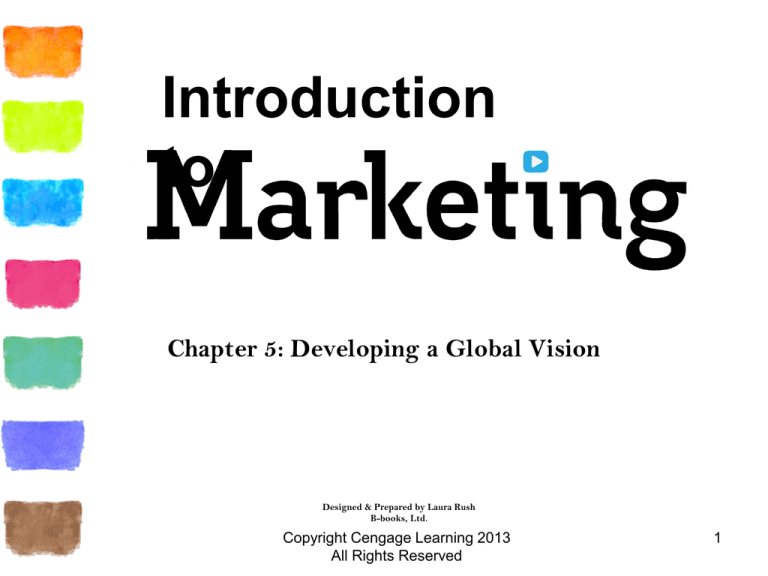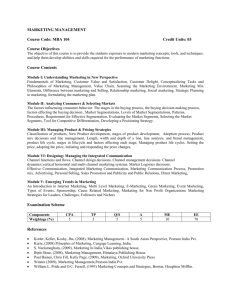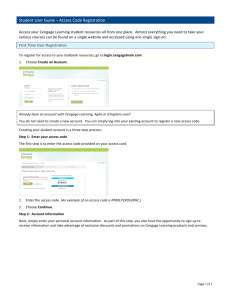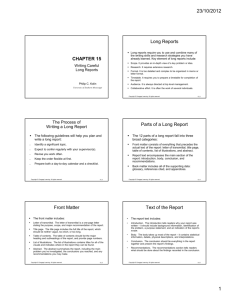
Introduction
to
Chapter 5: Developing a Global Vision
Designed & Prepared by Laura Rush
B-books, Ltd.
Copyright Cengage Learning 2013
All Rights Reserved
1
Learning Outcomes
LO1
Discuss the importance of global marketing
LO2
Discuss the impact of multinational firms
on the world economy
LO3
Describe the external environment facing
global marketers
Copyright Cengage Learning 2013
All Rights Reserved
2
Learning Outcomes
LO4
Identify the various ways of entering the
global marketplace
LO5
List the basic elements involved in
developing a global marketing mix
LO6
Discover how the Internet is affecting
global marketing
Copyright Cengage Learning 2013
All Rights Reserved
3
Importance of Global Marketing
to the U. S.
• U.S. exports a fifth of industrial production.
• Exports create jobs for 10 million Americans.
• Exports represent 13 percent of U.S. GDP.
• The United States exports over $1.7 trillion in
goods.
LO1
Copyright Cengage Learning 2013
All Rights Reserved
4
The Fear of Trade and
Globalization
• Millions of Americans
have lost jobs
• Millions fear losing jobs
• Threat of outsourcing if workers do not
accept pay cuts
• Vulnerability to operations moving
offshore
LO1
Copyright Cengage Learning 2013
All Rights Reserved
5
Benefits of Globalization
• Expands economic freedom
• Spurs competition
• Raises productivity and living standards
• Offers access to foreign capital, global export
markets, and advanced technology
• Promotes higher labor and environmental
standards
• Acts as a check on government power
LO1
Copyright Cengage Learning 2013
All Rights Reserved
6
Global Marketing Standardization
1. Operate somewhat differently in each
country
•
Different product features, packaging, and
advertising.
2. Communication and technology have
made the world smaller
•
Eliminated segmented foreign markets with
different products.
3. Success is based on variation, not on
offering the same product everywhere.
LO2
Copyright Cengage Learning 2013
All Rights Reserved
7
Culture
1. Underlies family, education, religion, and
social class
2. Influences product preferences and the
marketing mix
3. Country specific customs and traditions
•
•
LO3
Language
Business Practices
Copyright Cengage Learning 2013
All Rights Reserved
8
Economic and
Technological Development
Developed
Country
Complex, sophisticated
industries
Less Developed
Country
Basic industries
LO3
Copyright Cengage Learning 2013
All Rights Reserved
9
Legal Considerations
Tariff
A tax levied on goods entering
a country
Quota
Limit on the amount of a
product entering a country
Boycott
Exclusion of products from
a country
Exchange Control
Foreign exchange must be
sold to a control agency
Market Grouping
Common trade alliance
Trade Agreement
An agreement to stimulate
international trade
Copyright Cengage Learning 2013
All Rights Reserved
10
The Uruguay Round
• Entertainment, pharmaceuticals,
integrated circuits, and software
• Financial, legal, and accounting services
• Agriculture
• Textiles and Apparel
• Created the World Trade Organization
(WTO)
LO3
Copyright Cengage Learning 2013
All Rights Reserved
11
Demographic Makeup
Marketing Considerations:
• Population density
• Urban or rural
• Personal income
• Age
LO3
Copyright Cengage Learning 2013
All Rights Reserved
12
Shortages in Natural Resources
Create…
• International dependencies
• Shifts of wealth
• Inflation and recession
• Export opportunities if resources
are abundant
• Stimulus for military intervention
LO3
Copyright Cengage Learning 2013
All Rights Reserved
13
Global Marketing Questions
• What are our options in selling abroad?
• How difficult is global marketing?
• What are the potential risks
and returns?
LO4
Copyright Cengage Learning 2013
All Rights Reserved
14
Why “Go Global”?
• Earn additional profits
• Leverage a unique product or
technological advantage
• Possess exclusive market information
• Saturated domestic markets
• Excess capacity
• Utilize “economies of scale”
LO4
Copyright Cengage Learning 2013
All Rights Reserved
15
Entering the Global Marketplace
Export
Sell domestically produced
products to buyers in other countries
Licensing
Legal process allowing use of
manufacturing/patents/knowledge
Contract
Manufacturing
Private-label manufacturing by a
foreign country
Joint Venture
Domestic firm buys/joins a foreign
company to create new entity
Direct Investment
Active ownership of a foreign
company/manufacturing facility
Copyright Cengage Learning 2013
All Rights Reserved
Place (Distribution)
• Adequate distribution is necessary for
success in global markets
– Some countries have complicated systems
– Lack of distribution infrastructure and cultural
differences create problems
• Innovative distribution systems can create
competitive advantage
LO5
Copyright Cengage Learning 2013
All Rights Reserved
17
Pricing
• Must consider transportation and
insurance costs, taxes, and tariffs
• Determine what customers will spend
• Ensure that foreign buyers will
pay price
• May need to simplify a product
to lower price
• Don’t assume that low-income countries are
willing to accept lower quality
LO5
Copyright Cengage Learning 2013
All Rights Reserved
18
Dumping
1. Trying to increase an overseas market share
2. Temporarily distributing products to overseas
markets to offset slack demand at home
3. Lowering unit costs by exploiting large-scale
production
4. Attempting to maintain stable prices during
periods of exchange rate fluctuations
LO5
Copyright Cengage Learning 2013
All Rights Reserved
19
Countertrade
Countertrade- A form of trade in
which all or part of the payment
for goods and services is in the
form of other goods or services.
LO5
Copyright Cengage Learning 2013
All Rights Reserved
20



